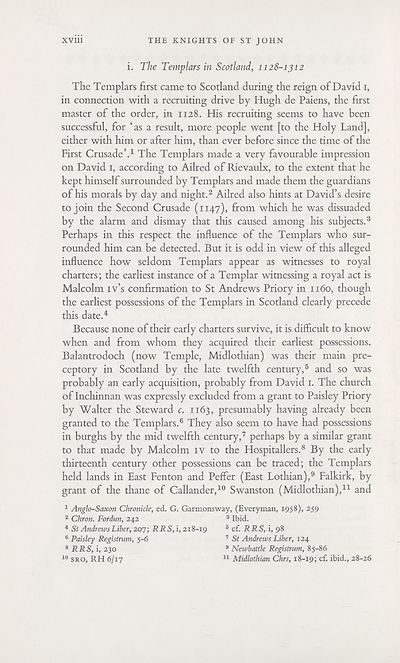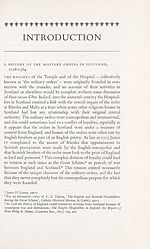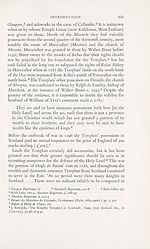Series 4 > Knights of St John of Jerusalem in Scotland
(23) Page xviii
Download files
Complete book:
Individual page:
Thumbnail gallery: Grid view | List view

xvm
THE KNIGHTS OF ST JOHN
i. The Templars in Scotland, 1128-1312
The Templars first came to Scotland during the reign of David 1,
in connection with a recruiting drive by Hugh de Paiens, the first
master of the order, in 1128. His recruiting seems to have been
successful, for ‘as a result, more people went [to the Holy Land],
either with him or after him, than ever before since the time of the
First Crusade’.1 The Templars made a very favourable impression
on David 1, according to Ailred of Rievaulx, to the extent that he
kept himself surrounded by Templars and made them the guardians
of his morals by day and night.2 Ailred also hints at David’s desire
to join the Second Crusade (1147), from which he was dissuaded
by the alarm and dismay that this caused among his subjects.3
Perhaps in this respect the influence of the Templars who sur¬
rounded him can be detected. But it is odd in view of this alleged
influence how seldom Templars appear as witnesses to royal
charters; the earliest instance of a Templar witnessing a royal act is
Malcolm iv’s confirmation to St Andrews Priory in 1160, though
the earliest possessions of the Templars in Scotland clearly precede
this date.4
Because none of their early charters survive, it is difficult to know
when and from whom they acquired their earliest possessions.
Balantrodoch (now Temple, Midlothian) was their main pre-
ceptory in Scotland by the late twelfth century,5 and so was
probably an early acquisition, probably from David 1. The church
of Inchinnan was expressly excluded from a grant to Paisley Priory
by Walter the Steward c. 1163, presumably having already been
granted to the Templars.6 They also seem to have had possessions
in burghs by the mid twelfth century,7 perhaps by a similar grant
to that made by Malcolm iv to the Hospitallers.8 By the early
thirteenth century other possessions can be traced; the Templars
held lands in East Fenton and Peffer (East Lothian),9 Falkirk, by
grant of the thane of Callander,10 Swanston (Midlothian),11 and
1 Anglo-Saxon Chronicle, ed. G. Garmons way, (Everyman, 1958), 259
2 Chron. Fordun, 242 3 Ibid.
4 St Andrews Liber, 207; RRS,i, 218-19 5 cf- RRS, i, 98
6 Paisley Registrum, 5-6 7 St Andrews Liber, 124
3 RRS, i, 230 9 Newbattle Registrum, 85-86
10 sro, RH 6/17 11 Midlothian Chrs, 18-19; cf. ibid., 28-26
THE KNIGHTS OF ST JOHN
i. The Templars in Scotland, 1128-1312
The Templars first came to Scotland during the reign of David 1,
in connection with a recruiting drive by Hugh de Paiens, the first
master of the order, in 1128. His recruiting seems to have been
successful, for ‘as a result, more people went [to the Holy Land],
either with him or after him, than ever before since the time of the
First Crusade’.1 The Templars made a very favourable impression
on David 1, according to Ailred of Rievaulx, to the extent that he
kept himself surrounded by Templars and made them the guardians
of his morals by day and night.2 Ailred also hints at David’s desire
to join the Second Crusade (1147), from which he was dissuaded
by the alarm and dismay that this caused among his subjects.3
Perhaps in this respect the influence of the Templars who sur¬
rounded him can be detected. But it is odd in view of this alleged
influence how seldom Templars appear as witnesses to royal
charters; the earliest instance of a Templar witnessing a royal act is
Malcolm iv’s confirmation to St Andrews Priory in 1160, though
the earliest possessions of the Templars in Scotland clearly precede
this date.4
Because none of their early charters survive, it is difficult to know
when and from whom they acquired their earliest possessions.
Balantrodoch (now Temple, Midlothian) was their main pre-
ceptory in Scotland by the late twelfth century,5 and so was
probably an early acquisition, probably from David 1. The church
of Inchinnan was expressly excluded from a grant to Paisley Priory
by Walter the Steward c. 1163, presumably having already been
granted to the Templars.6 They also seem to have had possessions
in burghs by the mid twelfth century,7 perhaps by a similar grant
to that made by Malcolm iv to the Hospitallers.8 By the early
thirteenth century other possessions can be traced; the Templars
held lands in East Fenton and Peffer (East Lothian),9 Falkirk, by
grant of the thane of Callander,10 Swanston (Midlothian),11 and
1 Anglo-Saxon Chronicle, ed. G. Garmons way, (Everyman, 1958), 259
2 Chron. Fordun, 242 3 Ibid.
4 St Andrews Liber, 207; RRS,i, 218-19 5 cf- RRS, i, 98
6 Paisley Registrum, 5-6 7 St Andrews Liber, 124
3 RRS, i, 230 9 Newbattle Registrum, 85-86
10 sro, RH 6/17 11 Midlothian Chrs, 18-19; cf. ibid., 28-26
Set display mode to:
![]() Universal Viewer |
Universal Viewer | ![]() Mirador |
Large image | Transcription
Mirador |
Large image | Transcription
Images and transcriptions on this page, including medium image downloads, may be used under the Creative Commons Attribution 4.0 International Licence unless otherwise stated. ![]()
| Scottish History Society volumes > Series 4 > Knights of St John of Jerusalem in Scotland > (23) Page xviii |
|---|
| Permanent URL | https://digital.nls.uk/126637791 |
|---|
| Description | Over 180 volumes, published by the Scottish History Society, containing original sources on Scotland's history and people. With a wide range of subjects, the books collectively cover all periods from the 12th to 20th centuries, and reflect changing trends in Scottish history. Sources are accompanied by scholarly interpretation, references and bibliographies. Volumes are usually published annually, and more digitised volumes will be added as they become available. |
|---|


